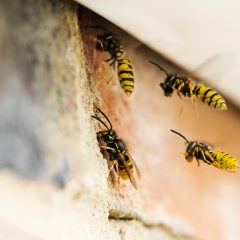As the weather turns colder, most people assume wasps have disappeared for the year. Yet many homeowners across Bath, Bristol, Chippenham, and the surrounding areas are surprised to find them still buzzing around indoors.
In many cases, these late-season visitors aren’t the typical worker wasps we associate with summer picnics; they’re queen wasps. The unseasonably warm autumns the UK has experienced in recent years have kept these queens active longer than usual, leading to increased sightings inside homes and commercial buildings.
At BEEKIND™ Pest Control, we’ve seen a significant rise in reports of wasps in lofts, spare rooms, and wall cavities during the colder months. Understanding why this happens starts with learning more about the queen herself; that’s what this blog is all about.
What Are Queen Wasps?
A queen wasp is the reproductive female responsible for founding and sustaining a new colony. After mating in late summer, she searches for a sheltered place to hibernate through winter, ideally somewhere dry, dark, and safe from predators or extreme temperatures.
Unlike worker wasps, which die off at the end of the season, queens are built to survive. When the weather is warmer than usual, some fail to enter full hibernation, becoming semi-active and occasionally emerging indoors through vents, loft spaces, or gaps in rooflines.
Lifecycle of the Queen Wasp
The queen’s year follows a precise biological rhythm, one that can be disrupted by fluctuating temperatures. Her life cycle typically unfolds as follows:
- Autumn (Mating and Preparation): The queen mates and leaves her nest to find a suitable hibernation site.
- Winter (Hibernation): She remains dormant in protected spaces such as attics, loft insulation, or wall voids.
- Spring (Emergence and Nest Building): As temperatures rise, she wakes, chews wood fibres to make paper pulp, and begins forming the first nest cells.
- Summer (Colony Growth): Once the first batch of workers hatch, they take over nest building and foraging while the queen focuses solely on egg-laying.
Each queen can lay between 100 and 300 eggs in the early stages and, as the colony matures, the total can reach up to 5,000 or more throughout the season. This incredible reproductive rate explains why wasp problems can escalate rapidly if left untreated.
Common hibernation and nesting locations include:
- Loft insulation and rafters
- Eaves and roof voids
- Sheds and garages
- Behind wall cladding or fascia boards
Why Are Queen Wasps Appearing Indoors Now?
Normally, queen wasps remain inactive until late spring. However, warmer-than-average winters are confusing their natural cycles. A queen that senses warmth may believe spring has arrived and prematurely emerge from hibernation, only to find herself trapped indoors.
Because lofts and attics often retain heat from living spaces below, they’re among the most common areas to find overwintering queens. Other typical entry points include:
- Chimneys and extractor vents
- Light fittings in loft conversions
- Cracks around roof tiles or brickwork
- Air bricks and soffit gaps
This is why sightings spike during mild spells, and why early, professional intervention is crucial before new nests are established.
Treatment Options
Many homeowners attempt to use traditional wasp powders or sprays designed for visible nests. Unfortunately, these products are rarely effective against queen wasps, which may be spread throughout loft insulation or deep within wall cavities.
Because of the sheer number of eggs laid and the queens’ dispersed locations, targeted nest treatments no longer reach all affected areas. Instead, fog treatments offer a far more comprehensive and reliable solution.
How Fog Treatment Works
Fogging involves dispersing a fine insecticidal mist that penetrates all the hard-to-reach voids where queens may be hiding. At BEEKIND™, our team uses professional-grade fogging equipment to safely and effectively saturate lofts, attics, and crawlspaces.
The benefits include:
- Full Coverage: The mist reaches rafters, insulation, beams, and gaps where wasps hide.
- Quick Results: The treatment eliminates both active queens and potential larvae.
- Safe & Controlled: Our fully qualified technicians perform fogging in a non-invasive and safe manner for both occupants and pets.
- Prevention: By eradicating overwintering queens, you dramatically reduce the risk of springtime infestations.
Following treatment, we can advise on sealing entry points and proofing measures to prevent future problems—part of our complete insect control service.
What To Do If You Find Queen Wasps in Your Home or Business
If you spot a sluggish wasp indoors during the cooler months, it’s likely a queen emerging too early from hibernation. The best approach is not to attempt removal yourself. Disturbing a queen may prompt her to seek a new nesting site nearby or lead to multiple stings if others are present.
Instead, homeowners and business owners should:
- Avoid sealing entry points until a professional assessment has been made.
- Keep rooms ventilated to prevent wasps from gathering in one place.
- Contact a qualified pest control company for inspection and treatment.
When you call BEEKIND™ Pest Control, you can expect:
- A friendly, qualified technician to assess your property.
- Professional advice tailored to your building type and pest activity.
- Advanced insect control using fogging and prevention techniques.
- Guaranteed work and long-term peace of mind.
Call BEEKIND™ Today
Queen wasp activity may be an unwelcome surprise, but with the right help, it’s easy to manage. At BEEKIND™ Pest Control, we combine technical expertise with a personal, eco-conscious approach to keep your property pest-free. We proudly serve Bath, Bristol, Chippenham, Melksham, Trowbridge, and all surrounding areas, offering reliable insect control, bee removal, bird proofing, and rodent prevention services. Call us today on 01225 285825 or 01249 698335 to arrange a visit from our friendly team.











